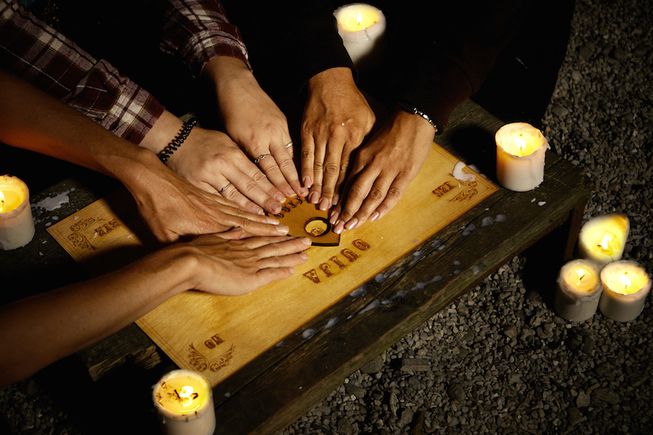The Ouija Board also known as ‘spirit boards’ or ‘talking boards’ are a flat panel of glossed wood, cardboard, or other smooth surface adorned with the letters of the alphabet, numbers ranging from zero to nine, the words ‘Yes’ and ‘No’ and typically ‘Goodbye’. There is a ‘planchette’ along with the board. It is typically a piece of plastic, wood, or glass with a circle cut out through which to view a letter on the board the alleged spirit wishes to communicate to you.
The actual word ‘Ouija’ is a made up word and is derived from ‘Oui’ and ‘Ja’, the French and German words (respectively) for ‘Yes’. Ouija Board literally means the ‘Yes Yes Board’.
The ‘Mystical Talking Board’ made its US debut in the early 1880s having carried over from London which had produced the boards since the mid 1880s with the earliest patent for a precursor to the board having been filed by a professor of music, Adolphus T Wagner in January of 1854. Wagner’s version of the talking board was called a ‘Psychograph’ or ‘Apparatus for Indicating Person’s Thoughts by the Agency of Nervous Electricity’. It was his hope that his device would allow for spirits to communicate at a broader level that the knocking and rapping heard in parlor seances that were taking the country by storm.
It was during the 1800’s that Europeans became infatuated with communicating with the dead. They began making their own ‘talking boards’ using flat planks of wood with etched markings for letters and a glass or tool that could easily slide across the board.
The paranormal boom of the 1800s in the United States saw an uptick in the number of talking boars per household. They were broken out at dinner parties where consenting adults used them to communicate with the world beyond. Slowly though, the world of the paranormal began to be equated with satanic worship and the Ouija board quickly fell out of favor and was frowned upon.
It wasn’t until the 1980’s, almost a hundred years after their introduction to America, that the movie ‘Witchboard’ thrust the device back into the pop culture zeitgeist. The highly successful horror film spawned two sequels and soon the talking boards were being sold on the shelves of toy stores everywhere. The Ouija was officially back and has remained accessible ever since, with boards continuously in manufacture.
The boards are fascinating, this can’t be denied. The idea that we are able to possibly communicate with those who have crossed over is an intriguing concept, but is it real?
The legitimacy of the Ouija Board has long been contested with science making some strong assertions that it is not ghosts or spirits moving the planchette at all, but subconscious muscle movements of the participants. These minuscule muscle movements produce what is called the ideomotor response or ‘IMR’. It is a complex process by which the brain forces the muscles of the body into reacting a certain way, subconsciously. In this case the brain, in trying to formulate a response to stimuli (the asking of a question), will cause minuscule movements to spell out responses. Simply put, we are moving the planchette and answering our own questions.
There are believes that when we use a board we are indeed communicating with those who have left the world of the living. There are forums where people share their experiences using the Ouija board and many are convinced of its validity.
Should you decide to use the Ouija board to communicate with the dead, be advised, there are long-held rules by which to abide:
Do no use it alone
The board allegedly requires the energy of two or more people that a spirit can channel to move the planchette. According to lore created for the “Witchboard” films, solo use of the board can lead to possession of the individual using the board.
Do not provoke the spirit
Should you be lucky enough to come into contact with one. Be respectful. Ask simple questions, and do not force the spirit to answer any questions it wishes to ignore.
Always close out a session by saying good-bye
Wait for the spirit to respond in kind. Some paranormal investigators feel that activity in a haunting can be traced back to an unclosed Ouija board session wherein the board will become a portal through which the spirit world can physically pass.
Do not let kids use it
Ouija, though marketed as a game, can become a source of consuming obsession. The concepts of death and spirits/ghosts are best left to mature adults who can process the weighty themes. Children who use the board can become preoccupied with the idea of death resulting in panic, fear, and the belief that there are ghosts, monsters and demons in the home.







